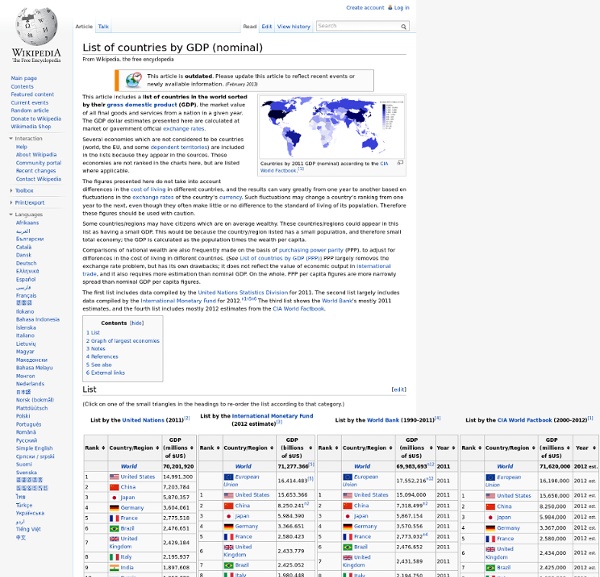List of countries by GDP (nominal) - Wiki
This article includes a list of countries in the world sorted by their gross domestic product (GDP), the market value of all final goods and services from a nation in a given year. The GDP dollar estimates presented here are calculated at market or government official exchange rates. Several economies which are not considered to be countries (world, the EU, and some dependent territories) are included in the lists because they appear in the sources. These economies are not ranked in the charts here, but are listed where applicable. The figures presented here do not take into account differences in the cost of living in different countries, and the results can vary greatly from one year to another based on fluctuations in the exchange rates of the country's currency. Such fluctuations may change a country's ranking from one year to the next, even though they often make little or no difference to the standard of living of its population.
LOGOS Investimentos - AAI Agente Autonômo de Investimentos
Top 10 World's Best Countries To Live In 2014
So where on earth the happiest people are living? What could be the best place to live, work, raise your children and retire? Go through the updated list of best countries to live in 2014 and get answer for all these questions. This list is prepared based on the recent “world happiness report” released by United Nations General Assembly. GDP per capitaSocial supportGenerosityFreedom from corruptionLife expectancyFreedom of making choices Happiness is the key in deciding the best countries. People who are emotionally happier, who have more satisfying lives, and who live in happier communities, are more likely both now and later to be healthy, productive, and socially connected. It clearly states when people of the nation are happy, other factors will automatically fall in its support. When the world happiness report was released for the first time in 2012, it drew an international attention and now it’s time to go through the new one. Topped the list in the past year at no 3
b-on - Biblioteca do Conhecimento Online
Fundamental human needs
Human Needs and Human-scale Development,[1] developed by Manfred Max-Neef and others (Antonio Elizalde and Martin Hopenhayn), are seen as ontological (stemming from the condition of being human), are few, finite and classifiable (as distinct from the conventional notion of conventional economic "wants" that are infinite and insatiable).[2] They are also constant through all human cultures and across historical time periods. What changes over time and between cultures is the strategies by which these needs are satisfied. Human needs can be understood as a system - i.e. they are interrelated and interactive. In this system, there is no hierarchy of needs (apart from the basic need for subsistence or survival) as postulated by Western psychologists such as Maslow, rather, simultaneity, complementarity and trade-offs are features of the process of needs satisfaction. Classification of needs[edit] Max-Neef classifies the fundamental human needs as: Types of satisfiers[edit] Research[edit]
Related:
Related:



